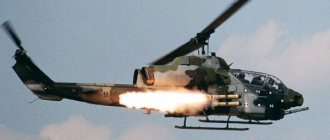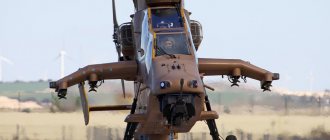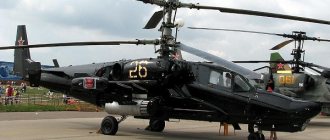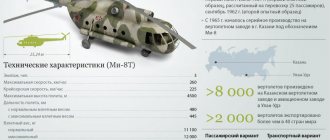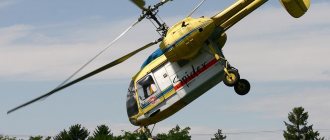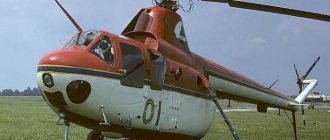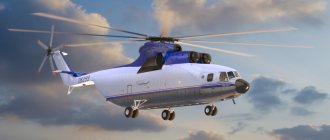Images of a Russian high-speed combat helicopter have appeared online
A promising Russian high-speed combat helicopter can be designed as a rotorcraft with coaxial rotors and two turbojet engines that will create thrust for horizontal flight and simultaneously drive the propellers. The promising helicopter has this configuration according to the project, some images from which were published by the Defense Blog portal, claiming that the pictures were found on one of the social networks. The published photographs, probably from the defense of the project, show an image of a helicopter and general designer Sergei Mikheev.
The Russian Ministry of Defense ordered the development of a high-speed combat helicopter capable of reaching speeds of more than 500 kilometers per hour late last year. The new aircraft will be created according to one of three schemes: classical (main and tail rotors), combined (rotorcraft with a main rotor, a wing and two pulling propellers) and coaxial (two bearing coaxial counter-rotating propellers and a pushing propeller in the tail). The new aircraft will receive a full range of helicopter weapons: an aircraft cannon, guided and unguided missiles of various classes and bombs.
Probably, the high-speed helicopter, images of which appeared on the Internet, is being developed by order of the Russian department. However, we can also talk about proactive development. Judging by the images, the promising rotorcraft will receive a delta-shaped wing, a front horizontal tail and a tail horizontal stabilizer, at the tips of which fins with rudders will be placed. It is planned to install universal hardpoints for missiles and bombs under the wing.
According to Defense Blog, the project involves the creation of a high-speed helicopter that can fly at speeds of more than 700 kilometers per hour. The crew of the car, judging by the images, will consist of two people seated side by side in the cabin. In the published photographs, the dimensions indicated for the helicopter are not readable. It can be assumed that the length of the car will be about 15 meters and the height - about six. The wingspan will be about 11 meters. Other details about the project are still unknown. In particular, it is not yet known whether the project will be implemented in hardware.
Defense Blog
Share
Kamov has already been designing a high-speed helicopter with turbojet engines that can be used to drive the main rotor and create motive force in horizontal flight. The project involved the creation of a Ka-90 helicopter, which would be capable of flying at speeds of up to 700-800 kilometers per hour. The project was first presented in 2008. He assumed that in horizontal flight the main rotor would stop, and its blades would fold back into a special fairing.
Today, several countries around the world are developing high-speed helicopters, including France, Germany and the USA. The goal of such developments is to create an aircraft capable of vertical takeoff and landing like a helicopter, and fast horizontal flight at speeds inaccessible to conventional helicopters. Airplanes with the ability to take off and land vertically are not suitable for the role of such aircraft. First of all, the reason for this is the very high fuel consumption during vertical takeoff and landing.
In addition, such aircraft cannot take off vertically with a large load and require a short run before takeoff. A high-speed helicopter will be able to take off and land vertically and reach speeds significantly higher than the speed of conventional modern helicopters, which usually does not exceed 300 kilometers per hour. In addition, a high-speed combat helicopter will significantly reduce the time required to strike enemy targets.
Since December 2015, the Russian Helicopters holding company has been testing a technology demonstrator of a high-speed helicopter, created on the basis of the transport and combat Mi-24. Last November, the Russian Helicopters holding company tested a high-speed helicopter technology demonstrator at maximum operational speed: the device flew at a speed of 405 kilometers per hour. This is an unofficial speed record among helicopters.
This machine is equipped with a main rotor, the tips of the blades of which have a teardrop shape. This form was created taking into account the avoidance of flutter and overcoming the “locking” effect. The technology demonstrator is expected to form the basis of several high-speed helicopter projects capable of flying at speeds in excess of 400 kilometers per hour. In particular, it is planned to develop a transport vehicle with a carrying capacity of up to 12 tons, a cruising speed of about 360 kilometers per hour and a maximum speed of just over 400 kilometers per hour.
Vasily Sychev
Convertiplane or high-speed helicopter Ka-92
“Recently, at meetings at the Ministry of Defense of the Russian Federation, where the command of the Russian Airborne Forces is also present, the question has again been raised about the possibility of developing and producing equipment called a tiltrotor for the needs of paratroopers.
...And yet we should hope that a tiltrotor for the Russian airborne troops will soon appear in the airspace of our Motherland” (zen.yandex.ru/media/bigwar/konvertoplan... November 10, 2020).
That's it, but the tiltrotor doesn't fit our airborne forces at all! In particular, the price of the Ka-92 = $30 million, and the cost of the serial tiltrotor V-22 “according to various sources, from 70 million to 110 million dollars” (12/30/2020 Do we need tiltrotors?).
Their carrying capacity is the same with a slight difference in speed, but the engine power of the V-22 is twice that of the Ka-92, i.e. Fuel consumption is also 2 times higher!
I don’t even want to talk about flight safety—an aircraft worse than a tiltrotor has yet to be invented:
“...after both engines fail (happens very rarely), using autorotation must make a safe landing. This, however, is complicated by the fact that its rotors have lower inertia and therefore lower ability to autorotate than conventional helicopter rotors. This makes emergency landings from a hover position below 500 m very dangerous, since such altitudes are too low to use the gliding capabilities of the wings” (invoen.ru).
Here's a little more detail. Carpet rotors have load-bearing and pulling propellers, i.e. in vertical modes they work like helicopter rotors, and in flight - like airplane propellers. The diameter of the screws for V-22 = 10.6 m; flight weight -24t. With such indicators, the tiltrotor will begin to fall sharply downward if the engines fail. And before landing, the crew will not be able to reduce the rapid speed, because... its propellers, again, due to their small size, and even three blades per propeller, receive a low inertial moment, which is needed to maintain the speed of the N.V. when reducing vertical speed.
The Ka-92 helicopter also has two rotors (coaxial), but with a diameter of 5 m. more and + 4 blades per propeller, and the flight weight of the helicopter is less by a third and = 16 tons, i.e. if the engines fail at any altitude, it will quickly and without problems switch to autorotation mode followed by a safe landing.
But the most important thing is that in the airborne forces, the tiltrotor will have to take off and land only like a helicopter, and due to the very small diameter of the main rotors, the tiltrotor will have no power reserve in hovering mode. Taking off from various “wells” is out of the question.
An example from Afghanistan: “The gorge was 50 m deep. At the bottom, in the bed of a dry river, paratroopers lay down. Seventy meters from them, one of the walls of the gorge was “saddled” by bandits. The wingman’s helicopter and a pair of Mi-24s, of course, covered the commander’s actions from above. The battle did not subside for a minute, but using SABs to illuminate the area during a firefight was like death. For the same reason, helicopters did not turn on their landing lights. The only way the paratroopers helped was to set the grass on fire: at least the outlines of the terrain became visible.
Railyan landed the helicopter in the gorge at the commands of the pilot-navigator, who leaned out waist-deep into the cockpit blister and corrected the actions of the crew commander: he told him the distance from the blades to the wall of the gorge - five meters, two, half a meter. Finally, the Mi-8 sat down on one wheel, since the local terrain did not allow landing in any other way. Meanwhile, it turned out that 16 more special forces soldiers were injured of varying degrees of severity, so that night the legendary squadron commander descended and ascended vertically several times at the commands of his navigator until he had taken all the wounded out of the ill-fated gorge (Remember Afghanistan | Weekly... vpk-news ).
For a tiltrotor, such a landing is excluded, but if it somehow lands empty, then it will not have enough propeller thrust for a vertical ascent from the bottom of the gorge, especially with wounded soldiers! For Americans, tiltrotor planes take off well only from the deck of an aircraft carrier, and helicopters handle extreme conditions when flying in rough terrain! In particular, their Boeing CH-47 Chinook longitudinal helicopters cope well with this task, and to replace classic helicopters, they are already nearing the end of testing high-speed coaxial helicopters S-97 and SB-1 in the new version of Defiant-X .
Our Airborne Forces have long had an impeccable project for the Ka-32-10AG helicopter based on the Ka-32 helicopter, which does not require large pre-production financial costs, and they will be replaced by high-speed Ka-92 and Ka-102, although the Kremlin government has not yet supported this initiative.
The Mi-8, with all its modifications, is no match for a coaxial helicopter, especially in terms of flight safety! In the last century, the Mi-8 was a truly outstanding helicopter, but its time is irrevocably gone and today the airspace of our country must be mastered by high-speed helicopters!
I will add that the Americans adhere to an aggressive policy, hence their need for long-range rotary-wing vehicles with high speed, even at the expense of payload. Our military strategy is defensive, when in tactical landing operations it is not so much the flight range that is important, but the helicopter’s ability to quickly take off and land with a larger number of fighters, especially in hard-to-reach places.
And God forbid, if a war breaks out with NATO: helicopter pilots will meet its beginning on outdated Mi-8 and Mi-28 helicopters, just like our pilots will meet the beginning of WWII. met on outdated I-16 fighters. But if the I-16s lost in battle to modern Messers, then the Mi-8/28 helicopters will be shot down even by small arms from the ground along the tail boom - at the most vulnerable spot of a classic helicopter. And their speed is low - from the last century - and plus the low altitudes at which these helicopters continue to fly, then everything taken together will allow enemy soldiers to camouflage themselves in advance, aim and shoot accurately at the target, taking into account the fact that the tail rotor will notify them of their arrival long before arrival!
Not only are coaxial helicopters not afraid of damage. beam, then they are also much simpler in piloting technique, and when the clumsy Mi-28 is put into service instead of the highly maneuverable Ka-50, and the outdated Mi-171A2 is launched into production instead of the high-performance Ka-32-10AG, then I personally regard this as a crime against the state under the guise of lobbying! The obvious thing is that the Ka-32-10AG is capable of transporting 1.5 tons. the payload is larger than the Mi-171A2 helicopter with the same engines and the advantage will be its lower drag, which means it is also faster and more economical. It would seem - what’s incomprehensible here? But the worst option is launched into the series of these competitors - the Mi-171A2 helicopter. If this is not sabotage, then what is it???
And this is how American soldiers are loaded into landing helicopters.
Our soldiers could land just as comfortably if they equipped the Russian Aerospace Forces with Ka-32-10AG helicopters! But government managers are prevented from launching this helicopter into series by a deep nostalgia for antiquity and, apparently, not on its own, but at the instigation of the United States, where Kremlin liberals may have deposits from the “introduction and production” of “high-speed” models and Mi-24LL helicopters with endless “upgrades” of the Mi-8 and Mi-26, which they do not need!
As an argument, I cite a remark about the Russian elite by Zbigniew Brzezinski : “If five hundred billion dollars of the Russian elite are kept in American banks, then you will decide whose elite it is, ours or yours . (August 4th, 2016, skeptimist.livejournal.com).
Now it becomes clear that the destruction of the unique, best design bureau Kamov in the world behind the screen of “optimization” and, of course, for the “good” of Russia, although in reality it was done for the good of the United States. And taking into account the fact that the Moscow Helicopter Plant Design Bureau named after. M.L. Mil after mastering the Mi-26 helicopter (1980) stopped working on the design and production of new generation helicopters, we can safely say that we now have NO helicopter design bureaus! For example, since 1980, the MVZ design bureau has developed and produced only mock-ups of the “high-speed” Mi-X1 helicopter and the “high-speed” “Rachel” helicopter for air exhibitions, and also converted the 2-seat Mi-24 cockpit into a single-seat one and this product under the designation The Mi-24LL is presented to us as a model of the helicopter of the future. Now we can state that the Americans’ desire (corrected ed.) to destroy our helicopter design bureaus has been COMPLETED in full!
And then, judging “it will do just like that,” the same managers supplied our paratroopers with the Mi-8s that had set their teeth on edge again.
By the way, there is a flight engineer (without headgear) standing behind him, who makes sure that in a hurry, no one gets hit by the tail rotor. Landing is Suvorov’s “speed and pressure”, so if they had carried out a combat mission on the Ka-32-10AG, the loading time for fighters would have been reduced significantly, and saving time in war is the most valuable combat component of a group of paratroopers.
No one denies that in Soviet times the Mi-8 helicopter was truly welcome, but everything has its time! He served his purpose faithfully and to replace him, the Kamov Design Bureau offered a project for the Ka-32-10 coaxial helicopter. But the development of this wonderful helicopter, which is very necessary for the State, has been frozen, probably now until the re-election of the President. It was similar in our State when N.S. Khrushchev reduced a good half of military aviation, and L.I. Brezhnev later restored it!
As for the attention that government officials are paying today to tiltrotors, it seems to me that everyone is laughing at the fake projects of “high-speed” Mi helicopters today: “The promising high-speed helicopter, which is currently being developed by the Russian Helicopters holding company, can accelerate up to 500 km/h.” (500 km/h by helicopter: a flying car based on the Mi-24... tvzvezda.ru/news/).
Let me remind you that the speed record of the Mi-24 is 368.4 km/h. The more streamlined cabin of the Mi-24LL may have added another 5 km/h to its speed, but in fact: just as it was a Mi-24, it remains so, and especially since when it goes into production it will again come with a two-seater cabin . It was the single-seat cabin that turned out to be the reason for removing the Ka-50 from service. Then the cost center designers swore to convince the government of V.V. Putin that one pilot in a helicopter is not capable of fighting, although army test pilots in the Chechen war convincingly showed that the Mi-24 is clearly weaker, and the Ka-50 “Black Shark” helicopters fight to the fullest:
“The crews from the combat units did not know the capabilities of the Ka-50, as well as the features of piloting coaxial vehicles, and therefore after the first combat mission they gave an emotional but accurate assessment: 'This is not a flight, but some kind of fantasy. It's not clear who is covering whom." After which R. Sakhabutdinov announced the impossibility of completing the task of covering him with crews.” (A word about the “Black Shark”. June 20, 2006, Red Star)
The future, of course, belongs to high-speed Ka-92, Ka-102 helicopters and high-speed attack helicopters (HAT) from Sergei Viktorovich Mikheev! And the Mi-X1 models with Rachel and the Mi-24LL helicopter from the unforgettable “Ostap Bender” will continue their “beautiful” life in museums and drawings by the general. designer "V.R." N.S. Pavlenko with government “effective” managers - as a reminder to them of a happy past!
Vitaly Belyaev, especially for Avia.pro
Russian Aviation
In June, a promising Russian high-speed helicopter (PSV) will fly at speeds of up to 450 km/h. This was announced by Andrey Shibitov, Deputy General Director of the Russian Helicopters holding company for production and innovation.
“The laboratory helicopter is preparing to fly at a given speed; we expect this flight in early June and hope that at the first stage it will reach a speed of 400-450 km/h and then up to 500 km/h,” TASS quotes Andrei Shibitov as saying.
Work on PSV is divided into two parts. The first is a research activity called “Advanced High-Speed Helicopter.”
“A flying laboratory has been created in this direction, which, as you know, has already made its first flight,” Shibitov recalled.
Another part of this project is the creation of a promising medium commercial helicopter. Shibitov also noted that it was no coincidence that the appearance of the Mi-24 helicopter was used to create the PSV cabin. According to him, using a real flying car is the most optimal way to save money.
The PSV flying laboratory is an experimental aircraft created on the basis of the Mi-24 helicopter. It is equipped with new all-composite rotor blades. Some elements of the flying laboratory's fuselage have been modified, which significantly reduces air resistance and improves the aerodynamics of the helicopter at high speeds. In January of this year, the helicopter took off for the first time at the flight test complex of the Moscow Helicopter Plant named after M.L. Mile. It is planned that the car will go into production from 2022 and will be able to reach speeds of up to 500 km/h.
In addition, Shibitov said that Russian Helicopters is actively working on a new generation aircraft for the Russian Navy.
“We have repeatedly made a proposal to resume the creation of a new generation vehicle for the Navy. It’s gratifying that the Ministry of Defense heard us. We are actively working on this machine,” Shibitov said.
He noted that in parallel, “very large and serious work” is underway to repair existing ship helicopters.
Last summer, General Designer (part of Russian Helicopters) Sergei Mikheev told TASS about the development of a new deck helicopter. According to him, we are talking about the successor to the Ka-27 and Ka-29. The head of naval aviation of the Navy, Igor Kozhin, told TASS that by 2022 Kamov will create a “fundamentally new helicopter” for the military.
According to the agency, a promising helicopter is being created under the code “Lamprey”. It will be smaller than the Ka-27, but will retain the “traditional layout for Kamov helicopters.”
In addition, a ship version of the Ka-52 Alligator helicopter was developed for the Mistral-class helicopter carriers ordered in France. The deal fell through, but Russian Helicopters and the Russian Ministry of Defense reported that carrier-based Alligators would find use in the Navy.
Source: Rostec (https://rostec.ru/news/4518108)
- 03/22/2016 Shvabe has developed a sample of a new surveillance system for installation on promising helicopters
- 03/17/2016 Mi-28N “Night Hunter” replaced Ukrainian engines with Russian ones
- 01/19/2016 Avia plans to triple helicopter production in 2022
- 01/04/2016 Kazan Helicopter Plant starts production of Mi-38
helicoptershigh-speed helicopter
“Made with us” and on Yandex.Zen
Russia has developed a unique light multi-purpose high-speed helicopter (MSV) with the beautiful name “Afalina”. The Russian development runs on ordinary motor gasoline and, according to the developers, has no analogues in the world. The helicopter was created (HeliWhale) from the city of Kemerovo. It is expected that in 2016 the company will begin serial production of this Afalina MSV. The light two-seater helicopter will be able to solve a wide range of tasks, including special tasks in the interests of the Ministry of Emergency Situations, the Ministry of Internal Affairs and other Russian structures.
For the first time, the new helicopter was presented to the general public at the HeliRussia 2015 exhibition, which took place from May 21 to 23 in Moscow at the exhibition. According to RIA Novosti, this light two-seater helicopter is currently undergoing a set of practical tests with the prospect of launching a serial model of the helicopter into commercial production next year. At the exhibition, which took place in Moscow in May, a demonstration sample of the Bottlenose Dolphin was shown. Russian production, combined with technical solutions, has made it possible to significantly optimize the cost of one flight hour, which allows this light helicopter to be used to solve a wide range of different tasks, note the developers of the rotorcraft.
"Afalina" is a light two-seat single-engine helicopter, built according to a twin-rotor coaxial design with a tandem pilot position. Its aerodynamics are based on a further development of the ABC (Advancing Blade Concept). The small helicopter's maximum speed is 250 km/h (cruising speed 210 km/h) and its maximum flight range is 750 km. The take-off weight of the helicopter does not exceed 500 kg. At the same time, the aircraft currently has the best flight performance characteristics in its class and meets all the basic modern demands from consumers of such products. The high-speed capabilities of the helicopter and the increased size of its cabin provide an additional level of comfort during its operation.
owned by Kuzbass Capital Invest shareholder Yakov Kolesnik. At the same time, he fundamentally does not call his brainchild - Yakov Kolesnik opened a small plant for the production and repair of helicopters without financial support from the region and the state - a business. “Business is where money is made in the world today. We don’t have such a commercial goal, and we won’t have one in the future. We are currently doing design work and we love it. We develop helicopters, and money can be made on other things. My main task now is that the people who work with me here receive normal wages, as in normal countries, so that such activities are prestigious,” Yakov Kolesnik noted in an interview with one of the Kemerovo publications. In his understanding, a normal salary is about 100 thousand rubles a month.
Kolesnik considers such remuneration for work to be quite justified, since it is quite difficult to find specialists for the design and assembly of helicopters in Kemerovo. The chief designer of the light multi-purpose high-speed helicopter "Afalina" is a native of Novosibirsk, Mikhail Mamykin, who worked for 15 years in Novosibirsk at the famous Chkalov Aviation Plant (NAZ named after V.P. Chkalov). Specialists in plastic parts are from Kemerovo. They are headed by Maxim Ivlev, whom Yakov Kolesnik met during his school years in an aircraft modeling club and several years ago with difficulty persuaded him to leave the field of car tuning for aircraft manufacturing. This is the team that worked on a promising Russian new product.
In addition to the "Afalina", which has already been shown at the exhibition, there is also the "Afalina Turbo". This helicopter will be able to reach a maximum speed of up to 300 km/h in the air. The estimated price of future rotorcraft is about 150 thousand dollars. “Many people ask us, where do we get spare parts for the helicopter? So, we don’t take them anywhere, but made them ourselves. Nothing was stolen from anyone. In our project, the only things that are foreign are the things that they can’t do in our country—the engine and the electronics, that is, the navigation equipment. Everything else - frames, fuselage, blades, seats - was invented and manufactured in Kemerovo,” Kolesnik told reporters.
The Afalina MSV is the result of the painstaking creative work of a team of like-minded people, people who are fanatically devoted to aviation. In just four years, the production facility, which grew here from scratch literally in a vacant lot, turned into a full-fledged small, well-equipped and high-tech plant for the repair and production of light helicopters. The company's immediate plans include establishing serial production of helicopters and entering the Russian and international markets with the finished product. The Afalina helicopter can be useful for the needs of the Ministry of Emergency Situations, fuel and energy companies, air ambulances, for the needs of private and corporate clients, and used for training purposes.
In the backyard, Yakov Kolesnik has equipped a helipad; from time to time, helicopters of his friends who fly to visit him land on it. Kolesnik himself prefers a helicopter to a car for business trips around the region. The growing interest in small aviation in Kemerovo is so great that a private airfield was even opened in the regional center. Today you can learn to become a pilot at the Kemerovo flying club. Businessman Yakov Kolesnik himself believes that the use of light helicopters in modern life is economically justified and safe. According to him, a trained pilot will be able to correctly direct the helicopter even if the engine fails. “Once my engine failed at an altitude of 200 meters, and I landed in autorotation mode. Having landed, I turned off all electronics, listened to myself - there were no injuries, got out of the car and left. This is a normal situation,” Kolesnik noted.
Design Features
The engine on the Afalina is the German Rotax 914 UL with a power of 115 hp. The choice of engine was due to the fact that piston engines have high economic performance and also have a long service life. Such an engine is tens of times cheaper than a small gas turbine engine and consumes little fuel in cruising mode (up to 18-22 liters per hour). At the same time, the engine runs on ordinary automobile fuel - AI-95 gasoline, which is widely represented in Russia, and not on special aviation kerosene. Today, these aircraft engines are installed on many aircraft. The engine has proven itself to be very reliable and has been certified in Europe.
The main gearbox is the Kemerovo company’s own design. A two-stage gearbox is used. The first stage of the gearbox is a cylindrical helical gear, the second stage is a double-flow bevel gear with a circular tooth. An oil temperature sensor, a chip detector and a rotor speed sensor were placed in the second stage of the gearbox. The helicopter engine and gearbox are connected to each other by a transmission, which includes a damping elastic rubber coupling and an engagement clutch (in one unit).
The helicopter's supporting system is coaxial synchronized rotors. The blades are made of carbon fiber and are rigidly fixed in bushings.
Helicopter fuselage: truss frame, welded from pipes (St20). The helicopter's cabin, tail boom and empennage are made of glass-carbon fiber. The position of the pilots in the cockpit is tandem, the helicopter controls are paired. To maintain the required temperature in the pilot's cabin, there is a ventilation and air heating system on board.
The helicopter's skid-mounted aluminum chassis. To transport the machine on the ground, removable wheels are installed, which allow just one person to transport the helicopter to its stationary location without any problems.
An interesting feature is the ability to install the MVEN “Cobra”-500 high-speed parachute system on the helicopter. This is a pyrotechnic system with forced parachute deployment, which is able to save cargo weighing up to 500 kg. Nowadays, it is becoming more and more obvious that the use of parachute rescue systems, which in the event of an accident or emergency situation rescue pilots along with the aircraft, is the most rational way to increase flight safety on ultra-light aircraft. This is also proven by the statistics of successful applications of such rescue systems.
Purpose and scope of application of the Afalina helicopter
Today, throughout the world, light two-seater helicopters have a fairly wide range of applications. These machines are mainly used for:
— education and training of helicopter pilots; — aerial photography and terrain surveillance; — police patrolling;
— control of power lines and pipelines;
— transportation of medical personnel; — transportation of private individuals;
— administrative transportation;
— aviation agricultural work;
— work in fishing fields; — sport flights.
Flight characteristics of the Afalina helicopter:
Dimensions:
length - 7.2 m (without blades), width - 1.85 m, height - 2.8 m, rotor diameter - 6 m.
The number of main rotors is 2 (6 blades each).
Take-off weight - 500 kg.
The weight of the structure is 270 kg.
Payload weight - 180 kg.
Powerplant - Rotax 914 UL (115 hp). Fuel consumption - 18-22 l/hour.
Maximum flight speed is 250 km/h.
Cruising flight speed is 200 km/h.
The maximum flight range is 750 km.
Static ceiling - 2000 m.
High-speed helicopter for 7.5 billion rubles
Photo by Vitaly V. Kuzmin
According to Deputy Minister of Industry and Trade of Russia Yuri Slyusar, it is planned to spend more than 7 billion rubles on the development of a promising high-speed helicopter.
As Alexander Vatagin, executive director of Klimov OJSC, told RIA Novosti, the first prototype of a new generation engine for a promising high-speed helicopter will be created in 2015.
“We are talking about the development of a promising high-speed helicopter with a certificate for serial production in 2022. Now for the program, which has been implemented for two years, about 7.5 billion are provided for budget investments and the Russian Helicopters holding company,” Slyusar said.
The promising high-speed commercial helicopter should be certified by 2022. The head of the Russian Helicopters holding company, Alexander Mikheev, informed that the aircraft is currently at the preliminary design stage.
“Consultations are now underway with marketers and experts, as well as determining the speed of the car,” he said. Operators expressed that high speed is not a key parameter for them. “When developing a promising helicopter within the first stage, the main ones are economic indicators. The machine will be designed for consumers and at a given price,” explained Yuriy Slyusar.
Within the first stage, the main ones are economic indicators. The machine will be designed for consumers and at a given price.
Deputy Minister of Industry and Trade of Russia Yuri Slyusar
As part of the second stage, it is planned to co-finance and create, by 2025-2030, a scientific and technical basis for a helicopter from new materials, with a fundamentally new aerodynamic design, and new on-board radio-electronic equipment (avionics). The speed of the car created in the second stage is expected to exceed 450 km/h.
Earlier, the executive director of JSC Klimov, Alexander Vatagin, stated that the first prototype of a new generation engine for a promising high-speed helicopter will be created in 2015. In turn, the largest developer of avionics, the Radioelectronic Technologies Concern, reported that it had developed a set of avionics based on the “glass cockpit” principle for a promising high-speed helicopter, which will allow the pilot to monitor the situation on board without being distracted by instruments.
The project of a promising high-speed helicopter is unique for the domestic industry. “We are talking about a machine designed from scratch by the Russian Helicopters holding,” informed Yuri Slyusar. The promising high-speed helicopter will probably have a mass of 12-13 tons, that is, it will become a replacement for helicopters of the Mi-8/17 family.
United Engine Corporation (UEC) and the French company Turbomeca previously entered into an agreement of mutual understanding. The parties agreed on strategic cooperation in the development of a promising power plant for a new generation helicopter.
From the screw: Kamov and Mil design bureaus storm records, challenging Sikorsky
The Russian Airbase forum briefly published material with images of all the projections of the Advanced Combat Helicopter (PCB), which is being developed at the Kamov Design Bureau. The American military magazine Defense Blog managed to post the images with appropriate comments.
The material is sensational - the maximum speed of the PBB should reach 700 km/h. Many are skeptical about this prospect. Because serial high-speed rotorcraft have half the speed. For example, the Ka-52 Alligator is capable of briefly accelerating to 350 km/h, but its cruising speed is 260 km/h. The American AH-64D Apache has a maximum speed of 365 km/h.
Developers of ultra-high-speed helicopters are only approaching speeds of 500 km/h. Thus, a flying laboratory based on the Mi-24 with an ultra-modern propeller approached a speed of 450 km/h. Well, the unofficial world record, set on the experimental Franco-German Eurocopter X3, is 472 km/h. True, this is a special machine, in addition to the main rotor, it has two pulling ones at the wing tips. It is a hybrid of a helicopter and an airplane, and is called a rotorcraft.
And suddenly 700 km/h!
Kamov announced a way to accelerate a helicopter to 600 km/h
Russia has found a way to increase the speed of a combat helicopter to 600 km/h. TASS reports this with reference to the management of Kamov JSC.
General designer of Kamov JSC Sergei Mikheev claims that his company managed to find a solution with which it is possible to increase the speed of a combat helicopter to 600 km/h. Mikheev told reporters about this within the framework of the International Aviation and Space Salon MAKS-2019.
The general designer of the design bureau notes that at the moment “we are lagging behind the requirements that exist.”
The designer mentioned Boeing, which, together with the Sikorsky corporation, is creating a promising machine with a speed of 480-550 km/h. According to Sergei Mikheev, Russian programs do not yet have such indicators. However, he claims that Kamov managed to find a solution.
I managed to find a solution, I patented it, that a combat helicopter can fly at speeds of more than 600 km/h.
- Interfax quotes him as saying.
The main promising helicopter in Russia is not being developed by the Kamova Design Bureau.
Currently in Russia, the development of a promising high-speed helicopter is being carried out by the Milya design bureau.
The Kamov design bureau, known for its active use of coaxial designs in helicopter engines, has also developed its own version of the promising machine, but the Ministry of Defense is the main project of a competing bureau. The preliminary design of “Kamova” was a “synchrocopter” with two load-bearing rotors and one pusher propeller. Its estimated speed was supposed to reach 420 km/h. The design bureau is currently developing a new generation marine helicopter, the Lamprey.
Russian promising helicopter is on its way
The promising helicopter, which is currently being developed in the interests of the Russian Aerospace Forces, should go into production in 2022.
Viktor Bondarev reported this when he was Commander-in-Chief of the Aerospace Forces of the Russian Federation. Initially, it was assumed that a civilian version of the vehicle would be developed, but it turned out to be too expensive for commercial use, so all the developments were transferred to the military. At the moment, several countries are developing promising high-speed helicopters, since the maximum speed of modern rotorcraft usually does not exceed 300-350 km/h. At the moment, there are an extremely small number of cars that can overcome the 400 km/h bar: these are the S-97 Raider in the USA and the Eurocopter X3 in Europe.
